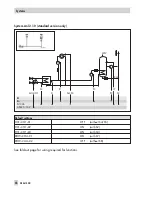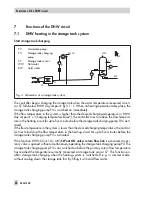
The level needs to be decreased and the gradient increased
if
the room temperature rises when it is mild outside
.
Outside the times-of-use, reduced set points are used for control:
The reduced flow set point is calculated as the difference between the adjusted values for 'HC1
day set point' (rated room temperature) and 'HC1 night set point' (reduced room temperature).
For heating systems without room sensor, the reduced flow temperature set point is based on the
'Night set-back, flow' parameter.
The 'Max. flow temperature' and 'Min. flow temperature' parameters mark the upper and lower
limits of the flow temperature. A separate gradient characteristic can be selected for the limita-
tion of the return flow temperature.
Examples for adjusting the characteristic:
4
Old building, radiator design 90/70:
Gradient approx. 1.8
4
New building, radiator design 70/55:
Gradient approx. 1.4
4
New building, radiator design 55/45:
Gradient approx. 1.0
4
Underfloor heating depending on arrangement: Gradient smaller than 0.5
Note:
For heating systems with room sensor and without configured influence of the room tem-
perature on the control process, the room temperature settings for day (HC1 day set point) and
for night (HC1 night set point) only become effective satisfactorily when the heating characteris-
tic has been adapted to the building/heating surface layout.
Functions
WE
Configuration
Four-point characteristic
OFF
HC1–CO1–11 = OFF
Parameters
WE
Parameter settings
Flow gradient
1.4
HC1–PA1–01 / 0.2 to 3.2
Flow level
0.0 °C
HC1–PA1–02 / –30.0 to 30.0 °C
Min. flow temperature
20.0 °C
HC1–PA1–06 / 5.0 to 150.0 °C
Max. flow temperature
90.0 °C
HC1–PA1–07 / 5.0 to 150.0 °C
Night set-back, flow
10.0 K
HC1–PA1–08 / 0.0 to 50.0 K
EB 5610 EN
55
Functions of the heating circuit
t
VL
t
A
[˚C]
[˚C]
20 0 –20
Summary of Contents for trovis 5600
Page 22: ...22 EB 5610 EN Setup settings B C D A A...
Page 124: ...124 EB 5610 EN...
Page 125: ...EB 5610 EN 125...
Page 126: ...126 EB 5610 EN Key number 1732...
















































